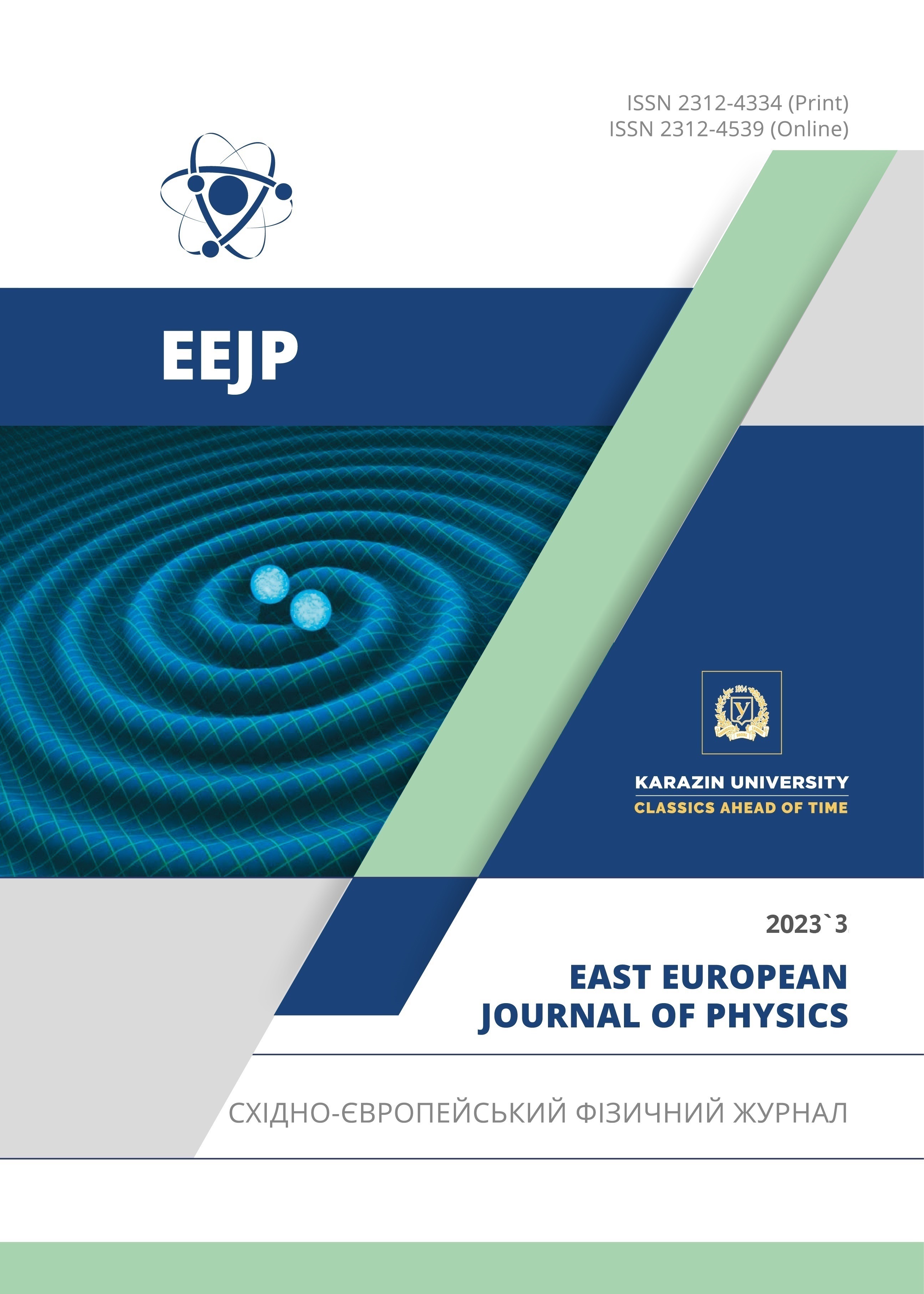SCAPS Numerical Analysis of Graphene Oxide /TiO2 Bulk Heterojunction Solar Cell Sensitized byN719 Ruthenium Dye
Abstract
Solid-state dye-sensitized solar cells (SSDSC) have been fabricated using two different metal oxide materials, graphene oxide and titanium oxide, are used as hole and electron transport materials, respectively. The N719 dye ruthenium between the hole and electron transport materials to act as an absorber layer in your Go/N719dye/TiO2 solar cells. Through the SCAPS-1D simulation, it was found that the Go/N719dye/TiO2 solar cells have significantly improved the performance of the solar cells compared to the Go/TiO2 solar cells. Specifically, the short circuit current (Jsc) has increased from 0.17 mA/cm2 to 1 mA/cm2, the open circuit voltage (Voc) has increased from 0.2 V to 1 V, and the power conversion efficiency (η) has increased from 0.02% to 2.5%. Additionally, Various factors that can affect the performance of Go/N719 dye/TiO2 solar cells. It was found that the optimal dye thickness for achieving high short circuit current density, high power conversion efficiency, and high open circuit voltage is between 200nm and 300nm. Furthermore, the operating temperature of the solar cells also affects their performance. Increasing the operating temperature negatively affects the open circuit voltage and power conversion efficiency of the cells, while the short circuit current density is slightly enhanced. Finally, the efficiency of a solar cell can be affected by the type of metal used for the electrode and the type of semiconductor material used in the cell. In Ni and Cu electrodes solar cells ohmic contacts allow for efficient transfer of electrons, whereas Schottky barriers can impede electron flow and reduce efficiency in Mo and Ag electrodes solar cells .
Downloads
References
A. Blakers, N. Zin, K.R. McIntosh, and K. Fong, “High Efficiency Silicon Solar Cells,” Energy Procedia, 33, 1-10 (2013). https://doi.org/10.1016/j.egypro.2013.05.033
J. Niederhausen, K.A. Mazzio, and R.W. MacQueen, “Inorganic–organic interfaces in hybrid solar cells,” Electron. Struct. 3, 033002 (2021). https://doi.org/10.1088/2516-1075/ac23a3
B. O’Regan, and M. Grätzel, “A Low-Cost, High-Efficiency Solar Cell Based on Dye-Sensitized Colloidal TiO2Films,” Nature, 353, 737-740 (1991). https://doi.org/10.1038/353737a0
N. Saleh, S. Al-Trawneh, H. Al-Dmour, S. Al-Taweel, and J.P. Graham, “Effect of Molecular-Level Insulation on the Performance of a Dye-Sensitized Solar Cell: Fluorescence Studies in Solid State,” J. Fluoresc. 25, 59-68 (2015). https://doi.org/10.1007/s10895-014-1479-8
R. Harikisun, and H. Desilvestro, “Long-term stability of dye solar cells,” Sol. Energy, 85, 1179-1188 (2011). https://doi.org/10.1016/j.solener.2010.10.016
N. Touafek, R. Mahamdi, and C. Dridi, “The performance of planar inverted perovskite solar cells employing graphene oxide as HTL,” Digest Journal of Nanomaterials and Biostructures, 16, 705-712 (2021). https://chalcogen.ro/705_TouafekN.pdf
Y. Wu, and G. Duan, “Inverted Planar Perovskite Solar Cells with High Electrical Conductivity and Efficiency by KBr-Doped PEDOT:PSS,” ECS J. Solid State Sci. Technol. 11, 025005 (2022). https://doi.org/10.1149/2162-8777/ac4d81
Y. Park, K.S. Choi, and S.Y. Kim, “Graphene oxide/PEDOT:PSS and reduced graphene oxide/PEDOT:PSS hole extraction layers in organic photovoltaic cells,” Phys. Status Solidi A, 209, 1363-1368 (2012). https://doi.org/10.1002/pssa.201228040
N. Tomar, A. Agrawal, V.S. Dhaka, and P.K. Surolia, “Ruthenium complexes-based dye sensitized solar cells: Fundamentals and research trends,” Solar Energy, 207, 59-76 (2020). https://doi.org/10.1016/j.solener.2020.06.060
H. Al-Dmour, R.H. Alzard, H. Alblooshi, K. Alhosani, S. Al Madhoob, and N. Saleh, “Enhanced Energy Conversion of Z907-Based Solar Cells by Cucurbit[7]uril Macrocycles,” Frontiers in Chemistry, 7, 562 (2019). https://doi.org/10.3389/fchem.2019.00561
M. Burgelman, P. Nollet, and S. Degrave, “Modelling polycrystalline semiconductor solar cells,” Thin Solid Films, 361-362, 527-532 (2000). https://doi.org/10.1016/S0040-6090(99)00825-1
H. Zerfaoui, D. Dib, M. Rahmani, K. Benyelloul, and C. Mebarkia, “Study by simulation of the SnO2 and ZnO anti-reflection layers in n-SiC/p-SiC solar cells,” AIP Conference Proceedings, 1758, 030029 (2016). https://doi.org/10.1063/1.4959425
N. Touafek, R. Mahamdi, and C. Dridi, “Boosting the performance of planar inverted perovskite solar cells employing graphene oxide as HTL,” Digest Journal of Nanomaterials and Biostructures, 16, 705-712 (2021). https://chalcogen.ro/705_TouafekN.pdf
N.S. Noorasid, F. Arith, A.Y. Firhat, A.N. Mustafa, and A.S.M. Shah, “SCAPS Numerical Analysis of Solid-State Dye Sensitized Solar Cell Utilizing Copper (I) Iodide as Hole Transport Layer,” Engineering Journal 26 1-12 2022. https://doi.org/10.4186/ej.2022.26.2.1
J.W. Lee, “Isothermal Electricity for Energy Renewal. PCT,” International Patent Application Publication Number WO 2019/136037 A1, (11 July 2019).
J. Nelson, Physics of Solar Cells, (The Properties of Semiconductor Materials), 1st edition, (Imperial College Press, 2003).
S. Daulay, A.F. Madsuha, E.S. Rosa, and A.H. Yuwono, “Fbrication of Titanium Dioxide-reduced Graphene Oxide (TiO2/rGO) nanocomposites as the Photoanode in Dye Sensitized Solar Cells,” Journal of Physics: Conference Series, 1402, 055101 (2019). https://doi.org/10.1088/1742-6596/1402/5/055101
J. Xi, L. Zheng, S. Wang, J. Yang, and W. Zhang, “Temperature-dependent structural fluctuation and its effect on the electronic structure and charge transport in hybrid perovskite CH3NH3PbI3,” Journal of Computational Chemistry, 42, 2213-2220 (2021). https://doi.org/10.1002/jcc.26750
A. Husainat, W. Ali, P. Cofie, J. Attia, J. Fuller, and A. Darwish, “Simulation and Analysis Method of Different Back Metals Contact of CH3NH3PbI3 Perovskite Solar Cell Along with Electron Transport Layer TiO2 Using MBMT-MAPLE/PLD,” American Journal of Optics and Photonics, 8(1), 6-26 (2020). http://dx.doi.org/10.11648/j.ajop.20200801.12
P. Sawicka-Chudy, Z. Starowicz, G. Wisz, R. Yavorskyi, Z. Zapukhlyak, M. Bester, Ł. Głowa, et al., “Simulation of TiO2/CuO solar cells with SCAPS-1D software,” Mater. Res. Express, 6, 085918 (2019). https://doi.org/10.1088/2053-1591/ab22aa
Copyright (c) 2023 Hmoud Al Dmour

This work is licensed under a Creative Commons Attribution 4.0 International License.
Authors who publish with this journal agree to the following terms:
- Authors retain copyright and grant the journal right of first publication with the work simultaneously licensed under a Creative Commons Attribution License that allows others to share the work with an acknowledgment of the work's authorship and initial publication in this journal.
- Authors are able to enter into separate, additional contractual arrangements for the non-exclusive distribution of the journal's published version of the work (e.g., post it to an institutional repository or publish it in a book), with an acknowledgment of its initial publication in this journal.
- Authors are permitted and encouraged to post their work online (e.g., in institutional repositories or on their website) prior to and during the submission process, as it can lead to productive exchanges, as well as earlier and greater citation of published work (See The Effect of Open Access).








